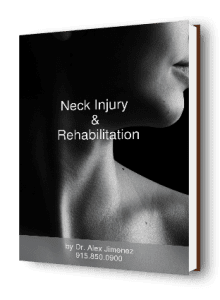Neck Pain Care & Treatments
Dr. Alex Jimenez’s collection of neck pain articles cover an assortment of medical conditions and/or injuries pertaining to pain and other symptoms surrounding the cervical spine. The neck consists of various complex structures; bones, muscles, tendons, ligaments, nerves, and other tissues. When these structures are damaged or injured as a result of improper posture, osteoarthritis, or even whiplash, among other complications, the pain and discomfort individual experiences can be debilitating. Through chiropractic care, Dr. Jimenez explains how the use of manual adjustments to the cervical spine can greatly help relieve the painful symptoms associated with neck issues.
Neck Pain and Chiropractic
The neck, medically referred to as the cervical spine, begins at the base of the skull and is made up of seven small vertebrae. The cervical spine, or neck, is capable of supporting the entire weight of your head, which is approximately 12 pounds. While the neck’s most fundamental function is to move the head in practically every direction, its own flexibility can increase the chances of complications, making the neck very susceptible to damage or injury.
The cervical spine is more susceptible to these types of issues mainly due to its biomechanics. Basic, everyday physical activities such as prolonged sitting and repetitive movements or accidents such as falls and blows to the body or head as well as normal aging, and everyday wear and tear caused by degeneration can affect the complex structures of the cervical spine. Neck pain can cause a good deal of discomfort and it can have a variety of causes. Understanding some of these reasons can help find the proper treatment.
The following are several of the most common causes of neck pain:
- Accidents and Injury: An abrupt movement of the head or neck in any direction, caused by a tremendous force where there’s a resulting rebound in the opposite direction is commonly identified as whiplash. The sudden whipping motion of the head or neck can cause damage or injury to the supporting tissues surrounding the cervical spine. When the body undergoes great force from an accident, the muscles tend to react by tightening and contracting, creating muscle fatigue which can result in pain and stiffness. Severe whiplash can also be associated with injury to the intervertebral joints, discs, ligaments, muscles, and nerve roots. Automobile accidents are the most common cause of whiplash.
- Aging: Degenerative disorders such as osteoarthritis, spinal stenosis, and degenerative disc disease directly affect the spine.
- Osteoarthritis is a common joint disorder that causes the progressive deterioration of cartilage. As a result, the body reacts by forming bone spurs that can affect the overall motions of the joints and other structures.
- Spinal stenosis is identified as the narrowing of the small nerve passageways found in the vertebrae, causing them to compress and entrap nerve roots. Spinal stenosis may cause symptoms of neck, shoulder, and arm pain, as well as numbness when these nerves are unable to function normally.
- Degenerative disc disease can cause a reduction in the elasticity and height of intervertebral discs. Over time, a disc may bulge or herniate, causing tingling, numbness, and pain that radiates into the arm.
- Daily Life: Poor posture, obesity, and weak abdominal muscles can alter the balance of the spine, causing the neck to bend forward in order to compensate for the changes. Stress and emotional tension can cause muscles to tighten and contract, leading to pain, discomfort and stiffness. Postural stress can contribute to chronic neck pain where symptoms may extend into the upper back and the arms.
 Chiropractic Care of Neck Pain
Chiropractic Care of Neck Pain
Chiropractic care is one of the most popular forms of alternative treatment utilized by individuals with neck pain. During the first visit to a chiropractor’s office, the healthcare professional will perform various types of exams to find the source of the symptoms as well as make an educated questionnaire about the individual’s current pain and discomfort as well as which remedies they may have already used. For instance:
- When did the pain begin?
- What has the person done for their neck pain?
- Does the pain radiate or travel to other parts of the body?
- Does anything reduce the pain or make it worse?
Additionally, a doctor of chiropractic, or a chiropractor, will also perform physical and neurological exams. In the physical exam, the spine specialist will observe your posture, range of motion, and physical condition, noting which types of movements and/or which other noticeable factors cause pain. Your doctor will feel your spine, note its curvature and alignment, and feel for muscle spasm. Checking the area around the shoulders is also important to determine other issues related to the spine. During the neurological exam, the healthcare professional will test the individual’s reflexes, muscle strength, other nerve changes, and the spread of pain and discomfort.
In some cases, your chiropractor may order additional tests to help diagnose whether an injury or condition is the cause of the symptoms. An X-ray can display narrowed disc space, fractures, bone spurs, or arthritis. A computerized axial tomography scan, also known as a CAT or CT scan, or a magnetic resonance imaging test, also known as an MRI, can display bulging discs and herniations. When the presence of nerve damage is suspected by the manifested symptoms, the doctor of chiropractic may order a special test known as electromyography, also known as an EMG, to measure how quickly your nerves respond to stimuli.
Chiropractors are conservative care doctors because their scope of practice does not include the use of drugs or surgery. If your doctor of chiropractic diagnoses a condition outside of this conservative scope, such as a neck fracture or an indication of an organic disease, they will refer you to the appropriate medical physician or specialist. He or she may also ask for permission to inform your family physician of the care you are receiving to ensure that your chiropractic treatment and medical care are properly regulated.
Chiropractic Adjustments
A chiropractic adjustment, also known as a spinal manipulation, is a precise procedure where a specific amount of force is applied to the joints of the affected area, in this instance the neck, and it’s usually achieved by hand. A spinal adjustment can function to improve the mobility of the spine and restore the individual’s original range of motion while also increasing the movement of the adjoining muscles. Patients generally report an improved ability to turn and tilt their heads and a reduction of pain, soreness, and stiffness.
According to the type of injury or condition diagnosed, your chiropractor will develop an appropriate treatment plan that may combine more than one type of treatment, depending on your personal needs. In addition to manipulation, the treatment plan may include mobilization, massage or rehabilitative exercises.
What Research Shows
One of the most current scientific literature reviews found evidence that patients with chronic neck pain who enrolled in clinical trials reported considerable improvements following chiropractic adjustments. A research study published in the March/April 2007 issue of the Journal of Manipulative and Physiological Therapeutics by researchers reviewed nine previously published trials and found high-quality evidence that patients with chronic neck pain demonstrated considerable pain-level improvements following spinal manipulation. No trial group was reported as having remained unchanged, and all groups showed positive changes up to 12 weeks post-treatment.
Check Out More Testimonials Over At Our Facebook Page!
Check Out Our Blog�Regarding Neck Pain
Spinal Health Integrative Care and Chronic Pain Relief
Your Spine, Your Life: An El Paso-Ready Guide to Strong, Flexible, Pain-Resistant Backs What “spinal health” means (and why it matters here in El Paso) Spinal health refers to the proper structure, alignment, and function of the spine, enabling it to support the body,...
Weekend Athletes Injury Solutions and Chiropractic Care
Weekend Athletes Injury Solutions: A Simple, Evidence-Based Guide for Safer Play and Faster Recovery Who this is for: adults who sit most of the week and then go hard on the weekend (a.k.a. “weekend warriors”). What you’ll get: clear reasons these injuries happen,...
Text Neck & Posture Importance Revealed With Chiropractic Care
Find out the role of chiropractic care in addressing text neck posture. Improve your well-being with expert care and guidance. Understanding Text Neck in 2025: Causes, Symptoms, Prevention, and Non-Surgical Treatments In our increasingly connected world, neck pain has...
Professional Scope of Practice *
The information on "Neck Injuries" is not intended to replace a one-on-one relationship with a qualified health care professional or licensed physician and is not medical advice. We encourage you to make healthcare decisions based on your research and partnership with a qualified healthcare professional.
Blog Information & Scope Discussions
Welcome to the wellness blog of El Paso Back Clinic, where Dr. Alex Jimenez, DC, FNP-C, a board-certified Family Practice Nurse Practitioner (FNP-C) and Chiropractor (DC), presents insights on how our team is dedicated to holistic healing and personalized care. Our practice aligns with evidence-based treatment protocols inspired by integrative medicine principles, similar to those found on dralexjimenez.com, focusing on restoring health naturally for patients of all ages.
Our areas of chiropractic practice include Wellness & Nutrition, Chronic Pain, Personal Injury, Auto Accident Care, Work Injuries, Back Injury, Low Back Pain, Neck Pain, Migraine Headaches, Sports Injuries, Severe Sciatica, Scoliosis, Complex Herniated Discs, Fibromyalgia, Chronic Pain, Complex Injuries, Stress Management, Functional Medicine Treatments, and in-scope care protocols.
Our information scope is limited to chiropractic, musculoskeletal, physical medicine, wellness, contributing etiological viscerosomatic disturbances within clinical presentations, associated somato-visceral reflex clinical dynamics, subluxation complexes, sensitive health issues, and functional medicine articles, topics, and discussions.
We provide and present clinical collaboration with specialists from various disciplines. Each specialist is governed by their professional scope of practice and their jurisdiction of licensure. We use functional health & wellness protocols to treat and support care for the injuries or disorders of the musculoskeletal system.
Our videos, posts, topics, subjects, and insights cover clinical matters, issues, and topics that relate to and directly or indirectly support our clinical scope of practice.*
Our office has reasonably attempted to provide supportive citations and has identified the relevant research studies or studies supporting our posts. We provide copies of supporting research studies available to regulatory boards and the public upon request.
We understand that we cover matters that require an additional explanation of how they may assist in a particular care plan or treatment protocol; therefore, to discuss the subject matter above further, please feel free to ask Dr. Alex Jimenez, DC, APRN, FNP-BC, or contact us at 915-850-0900.
We are here to help you and your family.
Blessings
Dr. Alex Jimenez, DC, MSACP, APRN, FNP-BC*, CCST, IFMCP, CFMP, ATN
email: coach@elpasofunctionalmedicine.com
Licensed as a Doctor of Chiropractic (DC) in Texas & New Mexico*
Texas DC License # TX5807
New Mexico DC License # NM-DC2182
Licensed as a Registered Nurse (RN*) in Texas & Multistate
Texas RN License # 1191402
ANCC FNP-BC: Board Certified Nurse Practitioner*
Compact Status: Multi-State License: Authorized to Practice in 40 States*
Graduate with Honors: ICHS: MSN-FNP (Family Nurse Practitioner Program)
Degree Granted. Master's in Family Practice MSN Diploma (Cum Laude)
Dr. Alex Jimenez, DC, APRN, FNP-BC*, CFMP, IFMCP, ATN, CCST
My Digital Business Card




